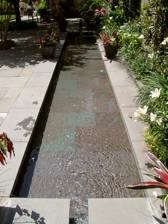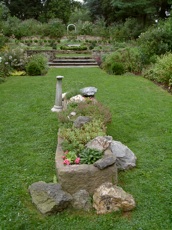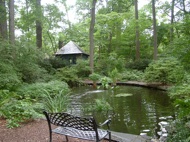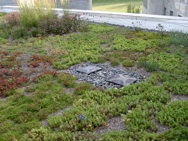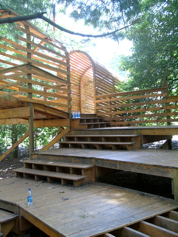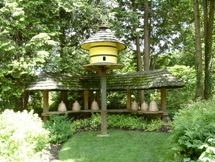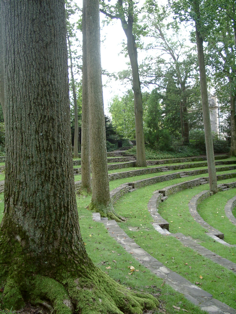arslocii
placeness as art


arslocii
placeness as art















Quest for artistic endeavor in
the Mid-Atlantic States
The wealth of gardens and arboreta within striking distance to us – the furthest in this group being Monkton, Maryland, at about 65 miles – is well, striking. One might be forgiven for thinking, given the plenitude, that the Mid-Atlantic region is the Garden Capital of the U.S. Certainly, the plethora of designed acreage in this part of the nation signifies that wealth and green go together. In Delaware alone there are so many du Pont estates and gardens that the smallest state may have the largest percentage area of landscaped grounds. Sometimes, the result is inspired. Often that inspiration involves landscape architects of note. Longwood Gardens is the largest and most renowned. We were looking for others, maybe less noted but certainly notable.
Ladew Gardens
Monkton, MD
Something that is always refreshing and welcome is a garden that doesn’t take itself oh-so-seriously. The fact that there are bizarre topiaries from the moment you enter the grounds (of a fox hunt, no less), makes one wonder if this is going to be some sort of hokey Disney-esque production. It isn’t. It’s more eccentric than that. And so much more imaginative fun. The layout of the grounds is a series of linked garden rooms, each with its own style, some fairly formal and traditional. Perhaps the formality is from before the designer really knew what the directional impulse was going to be, or maybe it was a structure that allowed a jumping off point for the unusual. Or, maybe the designer meant for different kinds of guests to be entertained in different settings, more attuned to their personal interests or sensibilities or eccentricities. Whatever the reason, the mix is refreshingly unique.
With more than twenty named garden zones, there is something to inspire every garden aficionado. We went for the quirkier ones, naturally: the Croquet Court, an Alice-in-Wonderland-y charmer; the Water Lily Garden, not for quirk but rather its beauty, calm and hiddenness (though this was a key characteristic of others, too); the Terrace Garden, with its secret rooms – one a small area with a huge umbrella-shaped trellis of climbing roses with a table encircling it in a slow waltz; the Sculpture Garden (because, let’s face it, most gardens lack this feature), made up of huge topiary, some resembling chess pieces. The individual topiaries are nice but not as unique or compelling as the garden-enclosing walls of topiary all about the property: undulating serpentine hedges, high geometric parapets looking very castle-like with garlands sculpted into and looping in and out of the walls of hemlock, privet or yew. But the best is the Yellow Garden, not so much for the yellow theme of its plant collection but more for the inclusion and encouragement of bees – a whole garden devoted to bees. The structures in that particular garden are fantastic: a yellow and black striped dovecote, woven bee skeps seated on their own curved shelf, covered by a shingled overhanging roof – looking like a shrine, or a Japanese teahouse’s machiai, with the hives waiting to be invited into the ceremony. Also, there is a yellow teahouse with a stylized pagoda roof that resembles a stinger. The entire landscape at Ladew is clever and serious fun.
Gibraltar
Wilmington, DE
Having no expectations is often helpful when visiting new gardens. Gibraltar is a place you could never imagine finding, but once you do find it, it appears as though it might be a ghostly apparition – kind of like Shangri-La. It is situated in an unlikely place off a major city road, with a large property housing a private school across from it, and older suburban-style developments of probably pricey homes all around. The garden is a vestige amid tight encroachment. Pulling into its parking area, you enter a past world – you are in a walled medieval-style courtyard, cobblestone floor surrounded by high stone walls. An L-shaped two-story stone carriage house/garage flanks two sides, with an arched opening for a steep ascending stairway. The long side of the L is topped at its second story by the skeleton of a formerly grand greenhouse, now without much glass, its “interior” open to the elements. Its structure is still compelling and the aged signs of wear and tear make the forecourt look even more ancient and incongruous. There is no one else around which, of course, adds to the unreality. Over to the left is another opening in the solid stone wall, an iron gate is ajar. It is the garden entrance. Now you enter another world – the world of formal garden design. This completely walled secret garden is a series of rooms that takes the viewer through nature as a gallery experience: vignettes as framed still lifes. Designed between 1916 and 1923 by landscape architect Marian Cruger Coffin, this gem is a delight made even more effective by its bizarre context. Although in a much nicer neighborhood, it has the feel of Chauncey’s anachronistic and timeless garden in “Being There.” The old manse on the hill is still hovering above its garden and is in dire need of repair. However, the terraced gardens, perhaps not with their youthful bloom, so to speak, are still radiant somehow. The balance of hardscape and plant materials is perfectly paired, and although the garden rooms connect, each is unique, taking you on a journey through beauty and timelessness. Gibraltar is not the sprawling site it might once have been, but what is there is “cherce.”
Chanticleer
Wayne, PA
Chanticleer bills itself as a pleasure garden. It’s funny when you consider that all gardens tend to be for pleasure, so how is this one different? There is a heightening of the senses that occurs here, and we believe it is because they not only employ gardeners but also artists. Sometimes the displays can get a little too theatrical, almost schmaltzy, but if you want the color rods in your eyes blown out in a good way, this is the place to go. The textures and shapes, though, often outshine the colors, and that is much appreciated since so many other gardens focus on the color first and foremost. Definitely a 20th century garden, it has its quiet spaces, too. Some of the older, immediate connections of house to garden (this was once the estate of pharmaceuticals kingpin Adolph Rosengarten and his wife, Christine) were created by landscape architect Thomas Warren Sears, who seems to have made beauty out of everything he touched – in this case the terraces and patios, including a runnel and fountain, and a pool area to die for. Sears definitely understood the effect of combining hard and soft materials, and his contributions are so elegantly simple and sensuous that they appear inevitable. The current crop of artists elaborating the mostly hilly landscape do some wonderfully creative things with borders and structures: in the Tea Cup garden, for instance, they have fashioned a living fence out of arched golden dogwood that is clever, subtle and beautiful. The Asian Woods are calming, and even the restrooms, built thematically to look like a Japanese teahouse, are a work of art. How often could you say that? The Cut Flower and Vegetable Garden is stylishly functional, with an asparagus border fence, arched arbors made from rebar holding trellised roses, weeping cedar and clematis. It looks like Mr. McGregor’s garden and it makes us feel a lot like Peter – wanting to stay there.
Barnes Foundation Arboretum
Merion, PA
The ownership of the world-famous Barnes Gallery and its impressive Impressionist art holdings have been steeped in controversy for many years. Visits there are focused usually on the interior collections, but it also has extensive gardens and an arboretum. It was a surprise to us. The impressive variety of Asian trees, the geometric layout of the rose garden and its connecting terraces, the classically domed wisteria arbor made of 1-1/4” steel pipe and the idyllic japanese-themed woods with a stream-fed pond and lovely stone slab crossings – all a pleasing discovery. But the best part is the Stewartia garden – a grove of peeling-bark trees whose trunks look like bone or animal skin with army-issue camouflage texture. The delicacy of the color that varies greatly from tree to tree is a mottled pointillism that could give Georges Seurat a lesson in subtle textures and refracted light. The grove is a sculpture gallery of strangely smooth but evidently living forms that create a wild and wonderful environment, and is some of the best art in the collection.
Scott Arboretum
Swarthmore College, PA
There is a certain irony in the fact that the former president of the largest paper producer in the world, Scott Paper Company, and the inventor of the throw-away paper towel, would endow an arboretum at his alma mater. One must wonder about the ratio of “harvested” trees to planted decorative specimens by Scott. But it shouldn’t and doesn’t take away from the beauty of the collection and the variety of the gardens.
The most magical of them, though, is Mr. Scott’s namesake Outdoor Amphitheater from 1941, with a woodland setting that should require a performance of “A Midsummer Night’s Dream” every season. Designed by Thomas W. Sears, it is gaspingly spectacular – combining the natural and manmade uniquely and inseparably. It is like finding an ancient ruin deep within a glen that fairies might now inhabit. Arslocii, indeed. The stone retaining walls that form the tiers and stairs of this theater combine with the “columns” of purposefully placed tulip poplars, both imposing presences and space-defining architectural elements, their canopy providing a majestic leafy cover high above the auditorium. This bit of magic, designed by Mr. Sears once again, and made entirely of natural materials, is the most breathtaking “garden” at the arboretum. It is art, in addition to its function, and it is theater itself. We would wager that if you go to any gardens and Sears was involved in the design, his contribution will be the most spectacular, the most necessary and the most compelling.
Another lovely site is the Terry Shane Teaching Garden, a kind of courtyard-style room with a vine-covered pergola and enclosed walls of hedges and perennials with an open, sunny center for, perhaps, mini-croquet. Another part of it offers shade and a round reflecting pool sunken into its flagstone surface.
But we also came here for the green roofs tour, which was edifying in a different way. After so much of the forested and/or designed color palettes that are offered in most plant collections, it was strange and welcome to see another aesthetic altogether. And even better is the purpose of these ‘scapes to reduce runoff, save energy and help replace or rebuild ecosystems that have been displaced by built structures. These drought-tolerant green roofs are something that might be more at home in the southwest, but they can be lovely as well as practical. The three that we saw were varied in age as well as design, spanning a six-year period that began in 2002. Mostly planted with multifaceted sedum varieties, the choice of the green material’s height is dependent on the depth of the soil. The color variation was surprising as was the textural interest, and, despite the fact that these roofs were not really designed to view, they have an intrinsic beauty that is different from the lushness our eyes are attuned to here in the East, but certainly have many subtleties to recommend them.
Tyler Arboretum
“Totally Terrific Treehouses”
Media, PA
Having had a desire to see this garden anyway, the perfect incentive to get there now was a temporary installation called “Totally Terrific Treehouses.” This was an imaginative and shrewd way to get people interested in trees (similar thinking to the Morris Arboretum) by inviting artists, architects and engineers to create ten unique structures that were in and/or interacted with individual and/or groups of trees. It’s a wonderfully playful concept and, besides, it fits perfectly with our thesis of arslocii as a natural/manmade dynamic. We had to check it out. And we were extremely pleased by what we saw. Probably, for our purposes, the best idea and execution were “The Tree Hugger” and “Imagination Station”; the former for its use of dead trees rather than live ones, and its creation of space through line, texture and shape; the latter for its sensitivity to its site and complete transformation of an area of ground into a sense of place (someone here took a cue from Fallingwater). Others were more fun as well as educational, but all were worth not only looking at but thinking about and definitely climbing into. One of the best temporary installations we’ve seen in years, it should be made permanent, if possible. Tyler has much to offer – a butterfly house, a pond, a meadow maze and a woodland. But they should keep the tree houses, too.

arslocii, a creation of Probasco Haus Press
copyright © 2010 Probasco Haus Press LLC

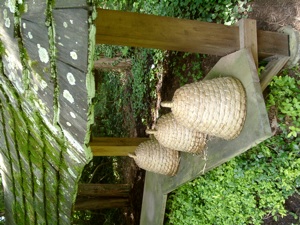



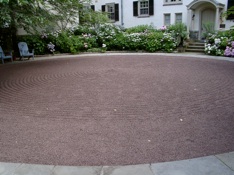
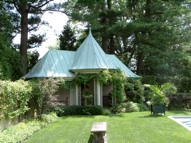
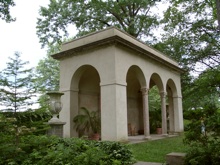
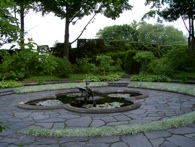
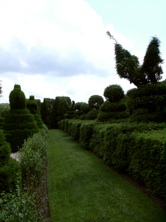




Top Left: Ladew’s Yellow Garden, dovecote and apiary.
Bottom Left: Gibraltar’s tea house pavilion at one end of the garden axis.
Right: Swarthmore’s Scott Outdoor Amphitheater.
